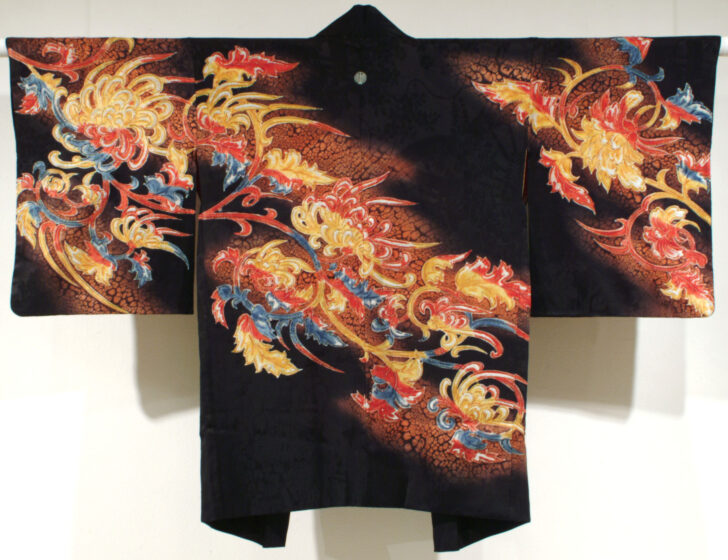Black crested haori with faux-resist dyed designs of chrysanthemum arabesques in yellow, red, and blue on crackled orange ground with embroidery
Minagawa Gekka

Description
Minagawa Gekka
Japan, ca. 1892–1987
Black crested haori with chrysanthemum design
Shōwa period (1926–1989)
ca. 1950
Black damask silk with wax-resist pattern, hand-painted designs,
and embroidery
Gift of Howard and Patricia Yamaguchi, 2005/1.351
Minagawa Gekka is known for his fresh, innovative textiles that
combine modern aesthetics and historic techniques. The flaming
scale pattern of the dragon on this haori is made using a complex
wax-resist dyeing technique from the eighth century. Gekka created
the chrysanthemum design using the yūzen technique developed in
his native Kyoto in the Edo period (1615–1868), outlining the flowers
in rice paste and then filling them in with vibrant colors. He added
dramatic texture by applying dazzling metallic embroidery. The
bold design, which is like a flying, fire-breathing dragon, contradicts
the understated elegance associated with the yūzen tradition.
The haori was originally part of a man’s formal attire. In the
twentieth century, it became the standard outerwear for women
dressing in kimono outside the home.
Summer 2023 Gallery Rotation
__________
Subject Matter:
The haori was originally part of a man’s formal attire, but in the nineteenth century, female entertainers in Edo (modern Tokyo) adopted it as a cloak for outdoor wear in mild weather. By the end of the century, married women of the upper class adopted black crepe silk haori with family crests (such as that seen here, at the back of the collar) for formal, public occasions. For much of the twentieth century, the haori has been the standard outerwear for a woman who dresses in a kimono outside the home. The twill pattern of palace carts and flower baskets is a traditional auspicious theme for Japanese women’s wear. Chrysanthemums are motifs of autumn season, and traditional clothes with this flower design are usually worn in fall.
Physical Description:
It is a black silk damask haori (short jacket for kimono) with wax-resist patterns, hand-painted design and metallic threads embroidery. The haori is in medium length, covering just underneath hip. It has elongated sleeves. The silk fabric is woven in a twill pattern of palace carts and flower baskets. Then the fabric is dyed with black. The white family crest under the collar and the diagonal part where chrysanthemum design would appear are left out from dying. The pinkish orange scale pattern is added using wax-resist technique. Chrysanthemum design is hand-painted with white, red, yellow, and blue colors. Finally embroidery is added in various metallic threads around the contours of the chrysanthemum petals and leaves.
Orange satin damask lining with woven wave design, with stenciled (?) designs of white flying cranes. Silver cord on one side, gold on the other, both with tassels.
Usage Rights:
If you are interested in using an image for a publication, please visit https://umma.umich.edu/request-image/ for more information and to fill out the online Image Rights and Reproductions Request Form.